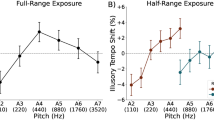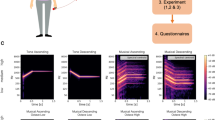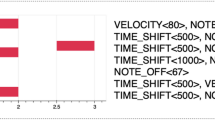Abstract
DIFFERENT opinions have been expressed about the way in which some people are able to recognize and identify the pitch of a tone without the aid of an external reference tone. Few people possess “perfect pitch” and it is not known whether it is learned or inherited1.
This is a preview of subscription content, access via your institution
Access options
Subscribe to this journal
Receive 51 print issues and online access
$199.00 per year
only $3.90 per issue
Buy this article
- Purchase on SpringerLink
- Instant access to full article PDF
Prices may be subject to local taxes which are calculated during checkout
Similar content being viewed by others
References
Cuddy, L. L., J. Acoust. Soc. Amer., 43, 1069 (1968).
Bachem, A., J. Acoust. Soc. Amer., 9, 146 (1937).
Brown, G. B., Klopper, A., and Loraine, J. A., J. Endocrinol., 17, 401 (1958).
Dalton, K., and Greene, R., Brit. Med. J., 4818 (1953).
Kopell, B. S., Lunde, D. T., Clayton, R. B., and Moos, R. H., J. Nerv. Ment. Dis., 148, (2), 180 (1969).
Margerison, J. H., Anderson, W. McC., and Dawson, J., EEG Clin. Neurophysiol., 17, 540 (1964).
Author information
Authors and Affiliations
Rights and permissions
About this article
Cite this article
WYNN, V. “Absolute” Pitch—a Bimensual Rhythm. Nature 230, 337 (1971). https://doi.org/10.1038/230337a0
Received:
Issue date:
DOI: https://doi.org/10.1038/230337a0



